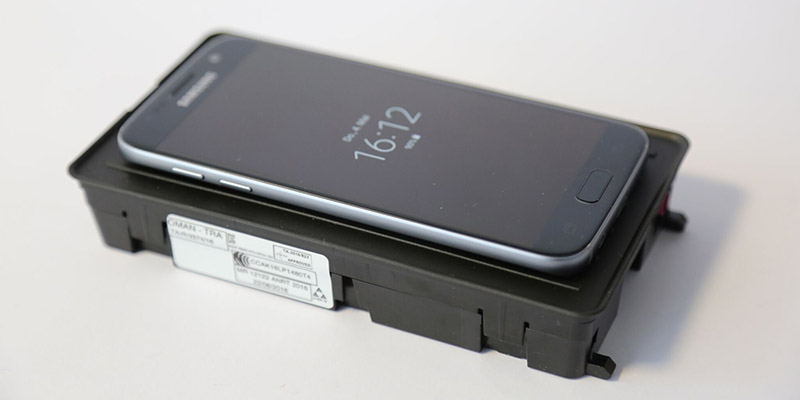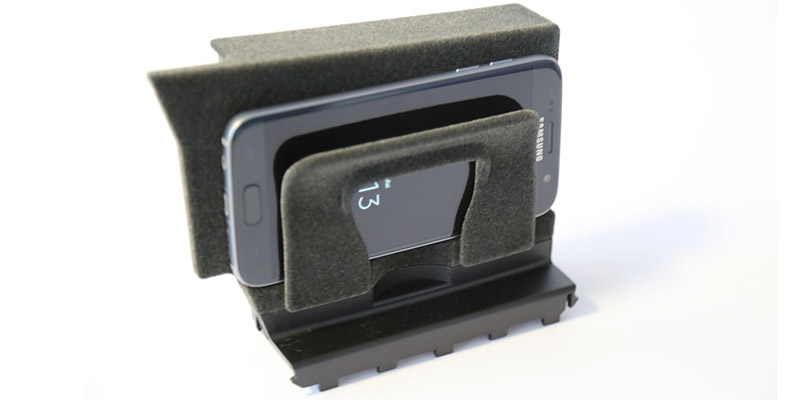Wireless charging for automobiles
The industry has seen the escalating use of smartphones and other mobile devices transform network traffic from mostly voice to a mix of integrated voice, video and data. There has also been a massive expansion of network coverage as people expect access to their content everywhere they go.
Most people today cannot imagine driving without their smartphones. Mobile phones deliver functionality far beyond simply placing a call, including GPS navigation, infotainment options (including podcasts, internet radio and playlists), voice-controlled texting, customisation of vehicle settings (such as the air conditioning and seat positions), apps from the vehicle manufacturer and data transfer with the cloud. The use of cell phones and other mobile devices is so prevalent that many car manufacturers now offer WiFi in the vehicle.
This expansion of cell phone usage requires a significant increase in sending and receiving data, and the more data a phone transfers, the shorter its battery life. The enhanced physical size and the quality of the display drain batteries faster than ever as well. Ten years ago, a fully charged cellular phone battery would last around a week. Today, the average battery life for a smartphone is just one day, making vehicle charging a very important issue.
Charging a smartphone in the car can be a challenging process, connectors do not always fit, adapters can be lost, cables can get tangled, connecting while driving can be a dangerous undertaking, and the charging capacity of the USB connector is low.
The obvious answer to this problem is the use of inductive charging, with a wireless transfer of energy between the smartphone and base station, which converts an input voltage into a constant output voltage. The key is the power supply unit, where the wound coils are installed separately for wireless charging. A magnetic field is created from a precisely defined frequency between 105 kHz and 205 kHz via the coils in the transmitter modules. The coils in the receiver devices receive electrical power with the identical frequency and generate voltage that charges the device’s battery.
Challenges
The development and implementation of wireless charging systems present significant design challenges. Electromagnetic compatibility (EMC) requirements in automotive applications are stringent. EMC is the unintentional generation, broadcast and reception of electromagnetic energy that can cause unwanted effects such as electromagnetic interference (EMI).
For example, unwanted EM fields can have a negative influence on the KeyFob system that controls vehicle door lock/open functions, trunk opening/closing, and critical remote engine start. It is vital that a wireless charging system does not emit EMC that interferes with the keyless go system. The development of advanced shielding techniques is essential to ensuring the coexistence of the wireless charging system with KeyFob and other critical car key communications.
Extreme temperatures have an adverse effect on both the mobile device and the wireless charging station. The typical operating temperature range is zero to 35°C. However, the interior of a vehicle sitting in the sun can reach well beyond 37°C. On a winter day, the temperature can drop well below zero. When not appropriately designed and protected, these drastic temperature changes can lower the performance of the charging system, and cause damage that renders it inoperable.
The efficiency of the wireless charging system is also an issue. When transferring power from the platform to the phone, some energy will inherently be lost. EMC shielding and thermal management play an important role in increasing the energy efficiency of this system.
Charging times for wireless charging modules are four millimetres are currently possible. Greater distances are achievable, but only at a higher transmitting power level, which negatively affects the critical EMC in a closed vehicle.
How to find the solution
With thousands of distinct smartphone models in existence, there is no single wireless charging design that can effectively power every model. The battery area on many phones is different, and the wireless charging system must be able to work with every version, no matter what the phone position is on the charging station.
In addition, every vehicle interior is different, including ergonomic design and electronic functionality. The need for a single platform that is easily and cost-effectively customisable to meet every vehicle’s specific design requirement is mandatory.
Wireless charging modules are almost never equipped with identical components; their efficiency in transferring power to the receiving device varies with the components used and the expertise regarding the design and build.

Communication protocols
There are currently two communication protocols used by two consortiums competing for the wireless charging standard. ‘Qi’ (pronounced "Chee") currently possesses a broader distribution range. Qi is part of the Wireless Power Consortium (WPC), a protocol that has been on the market since 2008 and unites more than 200 companies, including Microsoft, Samsung, Sony and almost all Android smartphone providers. The Consumer Electronics for Automotive (CE4A) Group represents the leading car manufacturers such as BMW, Audi and Daimler and has set Qi as the common standard.
Both the Alliance for Wireless Power (A4WP) and the Power Matters Alliance (PMA) are competitors, the latter of which connects consumer users like Starbucks and manufacturers such as HTC, Blackberry and Duracell. These organisations have been working closely together since January 2015. The PMA represents mobile device manufacturers, mobile service providers and hardware manufacturers and use its own software protocol ‘Powermat’, while A4WP uses a third proprietary protocol. So far, there are no plans to merge these two standards; they will continue to run in parallel despite the close cooperation between PMA and A4WP.
Although many smartphone models are made for wireless charging directly from the production line, not every model complies with Qi. In the near future, when consumers are selecting a next-generation smartphone, a decisive factor may be which device can use wireless charging irrespective of transfer protocols.
Currently, the Wireless Power Consortium (WPC) is operating in working groups to develop another protocol that takes the EMC problem into account. It is also working on wireless charging with the Qi protocol, which makes charging over an initial distance of around 50mm possible.
Laird’s solution
To achieve maximum device coverage, the Wireless Charging Units by Laird feature hardware to meet the broadest possible requirements. Qi currently possesses a broader distribution range. Qi is part of the Wireless Power Consortium (WPC), a protocol that has been on the market since 2008 and unites more than 500 companies, including Apple, Microsoft, Samsung, Sony and almost all Android smartphone providers. The Consumer Electronics for Automotive (CE4A) Group represents the leading car manufacturers such as BMW, Audi and Daimler and has set "Qi" as the common standard.
The latest Laird wireless charging modules for the automotive industry are highly efficient compared to the other systems on the market. The Laird design offers efficiency up to 62% (battery of the car to battery of the smartphone). There are virtually no extra losses compared to using cable connectors. Charging a smartphone via a cable or wirelessly through inductive charging basically takes the same amount of time with Laird’s latest modules, due to a patented EMC shielding design and temperature management systems.
By combining its wireless charging solution with antenna coupling, Laird offers additional functionality to increase reception/transmission of GSM, UMTS and LTE signals in all horizontal positions of the phone. This improves quality of service and enhances the user experience.
Temperature sensors on the surface of the board measure the surface temperature of the module to provide foreign object detection. A special heat sink has a contact to the wireless charging coils and is responsible for passive cooling of the module.
With an integrated controller chip for rectifying voltages, Laird offers a smarter wireless charging unit. If the battery is fully charged, or if the phone is removed, the charging shuts off automatically. In the case that the end user smartphone is not compatible with the Qi standard, the system switches off immediately and protects the phone from any interference.
Laird’s wireless charging modules are supplied in specific vehicle-related configurations defined by the automobile manufacturers. All products are individually designed and developed on the Laird Wireless Charging platform, but the form may vary depending on the requirements of the product designers. For vehicle manufacturers, completed modules are delivered to match the OEM’s design in the desired size and with a receiving slot for the smartphone.
These plug-in units are designed for installation in the central console and are fitted with a connector for system and power supply via the CAN Bus as well as with a coaxial connection to the upstream Compenser (antenna amplifier).

Conclusions
Wireless charging is seen as a commodity in the automotive sector. The vehicle is perceived as a living space, and for 2.6 billion people, smartphones have become an indispensable companion. This has resulted in the need for OEMs to design smartphone integration as conveniently as possible in the automotive environment. Wireless charging is the response to this market demand.
Developments continue for wireless charging in vehicles. Future device generations will be able to simultaneously charge multiple devices and have downward compatibility. In addition, other devices are to be used inductively – devices with irregular, non-planar 3D surfaces such as game consoles, cameras, toys or wearables such as watches.
A particularly exciting development for the automotive market is the integration of the Near Field Communication (NFC) standards, which will make other applications possible that have traditionally required high data security. By integrating NFC, wireless charging technology can be used for authentication, such as automatic termination of a rental transaction for car sharing, automated payment processes and augmented reality information.
Wireless charging solutions with high quality standards that provide OEMs the flexibility to develop unique solutions and are convenient for the user are essential.



